Robbin B. Sotir & Associates, Inc.
"Brushing Off Erosion"
Soil bioengineering techniques offer a natural way to repair streambank erosion while benefiting the environment
By Robin Sotir
Environmental concerns have become major issues in all aspects of urban watershed management. The results of non-point source impacts on streams, rivers, and the adjacent lands through which they flow in developed urban watersheds have become increasingly alarming. Restoration efforts, especially along stream corridors, must address issues such as habitat and water quality in addition to erosion protection.
Responsible upland slope watershed management combined with vegetated streambank protection is likely to address many of these concerns. Conversely, those solutions that make use solely of riprap, concrete, or other inert structures are being accepted less frequently because of their lack of environmental restoration benefits.
Consequently, there is great interest in designs that combine vegetation and inert materials into living systems that reinforce the soil and reduce erosion while providing environmental benefits. Soil bioengineering designs that employ woody vegetation as the main structural component are especially attractive because they can provide cost-effective habitat, water quality, aesthetic, and recreational benefits.
Environmental Benefits of Vegetation
Typical soil bioengineering systems employ vegetation for watershed restoration and consist of several structural components to combine into an integrated system that provides protection for the entire watershed. There are several vegetative components capable of providing immediate and long-term soil reinforcement and erosion protection for a given area. The selection will depend on the type and cause of the problem, as well as current and future planned use. The specific design selected may also depend on several other factors, including the level of risk that is acceptable, the time frame for improvement, and cost.
There are a number of environmental benefits associated with the most common soil bioengineering vegetative methods that are used for streambank protection. Methods that utilize woody vegetation, for example, may allow the creation or preservation of scour holes, provide shade for overhanging cover, and enhance riparian habitat.
Knowing the benefits of each soil bioengineering method allows designers to create streambank protection systems that enhance specific environmental benefits. For example, the overhanging vegetation that is provided by methods such as live siltation constructions, vegetated geogrid, and live cribwalls make them excellent choices for part of a bank protection system where shade and overhanging cover habitat is desirable. Over time, the riparian zone will enhance habitat for amphibians, fur-bearing animals, birds, and waterfowl. Such areas are critical for nesting, feeding, movement, and cover.
All soil bioengineering methods have a common benefit of providing root reinforcement in the soil mantle after establishment, as well as speeding up the process of natural invasion.
Understanding Environmental Features
To many people, scour holes in the channel bed and vegetation on the banks are conditions regularly on the list of problems to be corrected. In many cases this may be appropriate action. Environmentalists, however, recognize these features as valuable resting places and cover for aquatic species. This calls for careful evaluation of maintenance programs. Cover and cool temperatures are also achieved with shade provided by overhanging bank vegetation. Many aquatic species depend upon cool water temperatures for survival. The shaded water can provide safe harbors from predators. Pools and cover may be augmented with boulders, logs, root wads, or other materials that enhance hiding and resting areas for fish. In shallow streams where flow sinks into the channel bed during periods of drought, the creation of deep water pools can be crucial.
In 1989, when the city undertook an assessment of the creek, engineers recommended that the Long Leaf banks be stabilized by installing concrete culverts or "piping" down the entire length of the site. In 1996, a city bond issue raised $1.95 million for the project.
"We proceeded to hire (an interdisciplinary team of consultants) to look at several different alternatives and give us cost opinions for each one," Mayes says. In addition to piping the creek segment, options included:
Aquatic habitat
Productivity of urban streams is often reduced due to habitat deficiencies. But these deficiencies can be corrected by adding structures to the stream that are designed to provide food and cover for fish. Streambank protection offers unique opportunities to improve instream habitat, often with only a little additional cost. This is possible because of the streamside cover provided by vegetation incorporated into streambank protection and because some streambank protection structures create instream cover in the form of overhanging materials and deep pools. With slight modifications (and often at little extra cost), other streambank protection structures can be used to enhance fish habitat.
Riparian vegetation creates conditions that fish favor for cover by providing shade and dense structures from stems, leaves, and roots. Water velocities exert a great deal of influence over the distribution of fish in streams; therefore, the effectiveness of vegetation in enhancing fish habitat is related to the water velocity and cover provided at the specific site.
Rock banks often provide conditions conducive to fish with regard to water velocity but seldom provide the conditions favored as cover unless surface turbulence is present. The addition of vegetation to a rock revetment or levee can increase the level of use of the habitat and increase the likelihood that fish will be present under a wide range of discharges.
Opportunities for improving fish habitat depend primarily on the habitat deficiencies of the reach in question, the types of erosion problems, and the options and limitations for streambank protection. Streambank protection systems incorporating woody vegetation provide much-needed shade and streamside cover; whereas woody debris, boulders, and other features provide instream structure that modifies microhabitats and offers cover. Other habitat structures can be used to alter the area, depth, or volume of a reach and increase its value for a specific life stage of a species.
Riparian habitat
While it is true that a streambank's primary role is to confine stream flow, there is a strong biological value related to "edge effect" and biodiversity. The transition area between water bodies (streams, rivers, and lakes) and upland areas is called the riparian zone, and it represents some of our most valuable and diverse fish and wildlife habitats. The outdoorsman knows this is where he can find a brook trout lying under a root waiting for a caddis fly to drift by, where red foxes hunt mice, where muskrat and beaver build their lodges, where deer and frogs feed, and where turtles sun themselves. Accelerated erosion of streambanks can degrade these habitats, and some types of streambank protection such as concrete retaining walls and riprap can destroy this critical habitat.
Riparian zones are recognized as one of the most valuable resources
we have, especially in developed areas where they provide opportunities
for recreation, education, and communion with nature. Nearly all
riparian zones have four features in common:
In addition to being habitat for common species, these areas provide significant biodiversity for both plant and animal communities, including a number of varieties found nowhere else. The habitat diversity of riparian zones may be their most striking and interesting feature. Corridors bordering streams contain a rich abundance of plant and animal species thanks to the variety of aquatic, wetland, and upland habitats along and across the corridor. The bordering stream on one side and the adjacent uplands on the other constitute different ecosystems, and the riparian zone between contains plants and animals common to both. Plant communities along streambanks range from aquatics, mosses, and algae along the water's edge to shrubs and trees along upper banks and floodplain areas. They include a variety of sedges, grasses, and forbs that tend to dominate sites recently disturbed by erosion or human activities. This diverse assemblage of plants with its abundant leaf, fruit, and seed production, attracts a wide array of pollinating, decomposing, and predatory insects. In turn, many native birds utilize this type of habitat because of the smorgasbord. Much of this habitat is critical to reproduction of turtles and amphibians. The high productivity of riparian zones is derived partly from their habitat diversity and partly from the abundance of nutrients, water, and other resources found there. Plants provide the principal food resource and shelter for aquatic and terrestrial life forms, and plants grow rapidly in this wet, nutrient-rich environment.
Riparian zones are important corridors for the movement of large mammals and migrating birds because they tend to be relatively natural and interconnected. They are also avenues for the diffusion of plants and animals and are often the last refuge for plant and animal species threatened by human activities.
Streamside forests are crucial to the protection and enhancement of water resources. In addition to protecting streambanks from erosion, undisturbed riparian vegetation acts as a buffer that reduces sediment and pollutants entering streams and provides the shade necessary to maintain optimal temperatures and light conditions for aquatic plants and animals. A sufficiently wide strip of woody and herbaceous vegetation along a stream can be effective in reducing sediment and excess nutrients from run-off. Leaf litter and herbaceous growth capture sediment particles, and decomposing organic material under the surface binds nutrients, thereby allowing plants to recycle them. Removal of vegetation and the conversion of riparian zones to agriculture or other uses are often associated with streambank erosion, elevated water temperatures, reduction of dissolved oxygen, and the loss of food and cover for aquatic and terrestrial species.
Stream valleys and their water resources are often the focal point of a variety of recreational activities. Loss of riparian vegetation has negative impacts on aesthetics and on the fish, bird, and other animal populations that attract fishermen, hunters, and nature lovers to these areas. Protection and enhancement of these ecosystems are critical concerns because once lost, they are difficult to restore in their diversity and productivity.
Soil Bioengineering Techniques
In some instances, erosional failure sites will require repair, and new stream realignments will need to be stabilized and restored. The following are methods that offer immediate mechanical protection and soil reinforcement as well as environmental benefits.
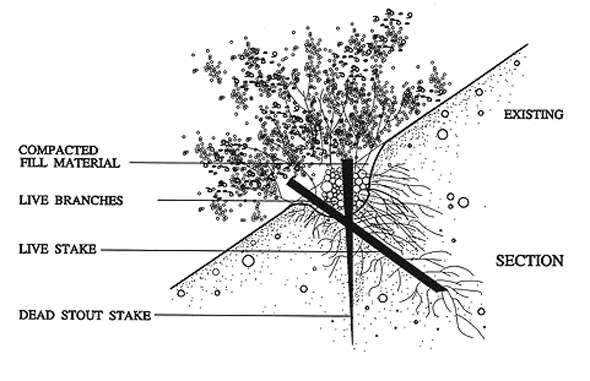 Figure 1
Figure 1
Live fascines are sausage-like bundles of long cuttings tied together and secured into banks (Fig.1). They are useful for areas of general bank scour where the banks can be sloped back. They assist in controlling overbank runoff by reducing the bank into a series of smaller, shorter banks. The live fascines provide immediate surface stability and an area for the invasion of the surrounding riparian vegetation. Over time, the live fascine provides shade, cover, and riparian habitat.
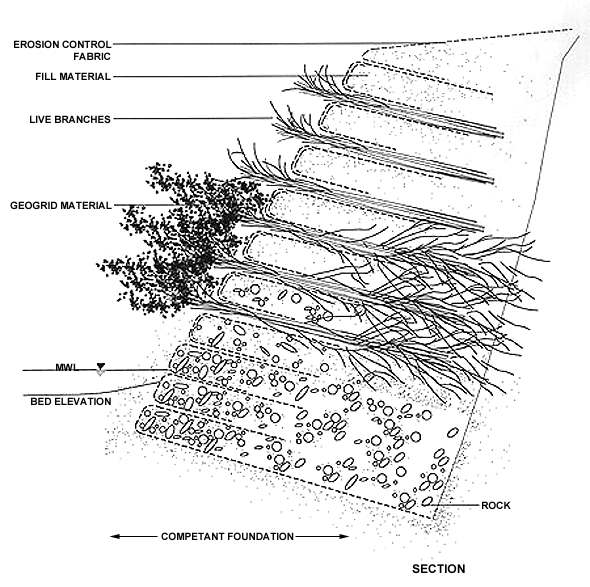 Figure 2
Figure 2
Vegetated geogrid structures are created by wrapping soil in natural or synthetic geotextile materials with live cuttings placed in between (Fig.2). They are useful for very steep sites when space is limited and banks cannot be cut back. Vegetated geogrids work well for the repair of eroding banks with local or general scour problems in outside meanders where the currents are strong. Vegetated geogrids are useful where land has been previously lost and needs to be restored. They provide immediate soil reinforcement, produce rapid growth, offer overhanging material for aquatic habitat, and become very natural in appearance and function.
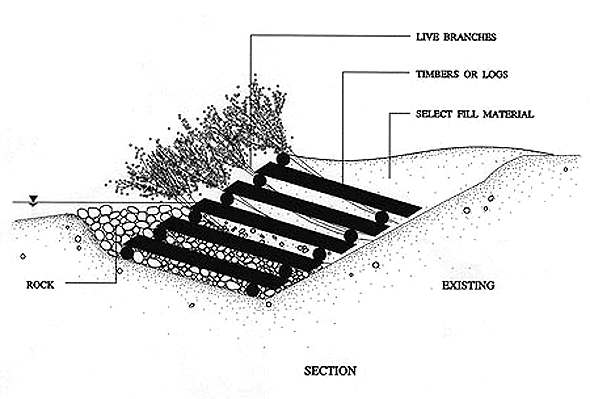 Figure 3
Figure 3
The live cribwall is a rectangular framework of timbers, soil, rock, and live cuttings (Fig 3). It is useful when space is limited or a slope cannot be cut back. Live cribwalls offer immediate bank protection and, over time, excellent vegetation for aquatic habitat.
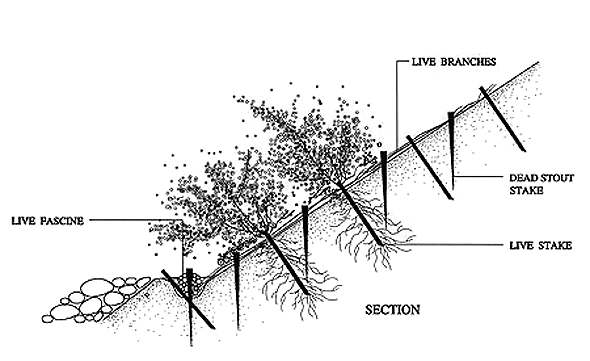 Figure 4
Figure 4
The brushmattress method is a system of living branches that form a cover over the streambank, providing immediate protection (Fig. 4). It is a useful system on high-velocity, steep-gradient streams where a bank can be cut back. This method roots and grows into an excellent natural riparian habitat zone.
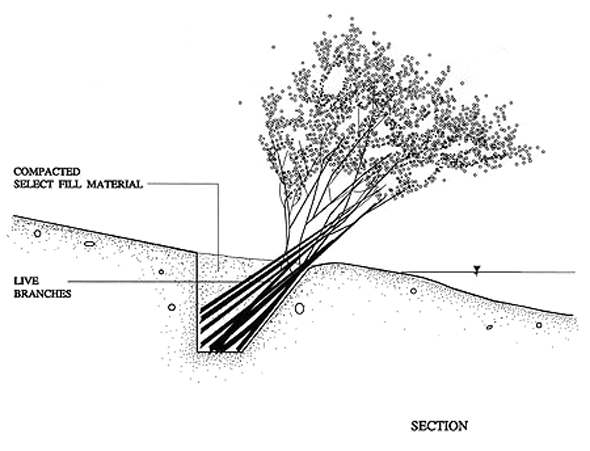 Figure 5
Figure 5
Live siltation constructions method is a system of living branches that form a cover over the streambank, providing immediate protection (Fig. 4). It is a useful system on high-velocity, steep-gradient streams where a bank can be cut back. This method roots and grows into an excellent natural riparian habitat zone.
Relocating an Oregon stream
Johnson Creek is located in Milwaukie, Ore, in the Portland metropolitan area. It is highly urbanized with land uses ranging from heavy industrial to low-density residential. The creek is a third-order stream with a 100-year discharge at the project site of about 4,000 cfs. The stream was enlarged (but not straightened) during the 1930's for flood control. A survey revealed that with few exceptions, streambanks are stable, heavily vegetated, and provide excellent riparian habitat and overhanging cover for the stream.
The Oregon Department of Transportation (ODOT) proposed relocation of a section of Johnson Creek for bridge and highway construction. The relocated section would be about 20 percent shorter than the existing channel with a commensurate increase in gradient.
The Johnson Creek Corridor Committee, which was created out of concern over degraded water quality and aquatic habitat, was concerned about potential impacts of the stream relocation. The relocated reach is in a highly visible location and the proposed ODOT design was for a traditional trapezoidal riprap rock channel. There was concern that the proposed design would present a stark appearance and cause loss of habitat.
ODOT retained soil bioengineering firm Robbin B. Sotir & Associates Inc. to form a team that would include habitat biology and fluvial geomorphology consultants. The team evaluated the proposed channel design for stability and potential impacts to aquatic and riparian ecosystems and modified the design as needed to address the concerns voiced by the committee. The review determined that the proposed channel cross-section shape and gradient were too uniform and that the floodplain berms were too high. The interdisciplinary team recommended changes to the channel that would improve stability, water quality, and habitat value. The channel cross section was altered by lowering floodplain berms, incorporating a subchannel sized to convey bankfull flows, and constructing a low-flow channel to concentrate flows during the summer months. The new compound channel proposal also included pool riffle sequences.
Streambanks were rocked to the ordinary high water elevation in the outside bends. Banks above were soil bioengineered using vegetated geogrids on the fill slopes to ensure immediate reinforcement and to offer overhanging cover for aquatic life. (Photo 1). Brushmattresses, live fascines, and live siltation constructions were used to provide riparian habitat, cover for waterfowl, and overhanging cover for fish (Photo 2).
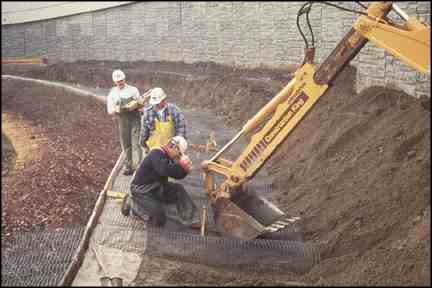
Photo 1
Vegetated geogrids ensure immediate reinforcement of fill slopes.
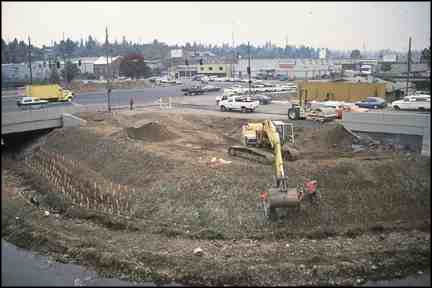
Photo 2
Rigarian Habitat is created with brushmattresses, live fascines, and live siltation constructions.
The soil bioengineering methods were installed during the winter of 1993 and spring of 1994. During the early spring and before the plants had established growth, the site experienced a 1,750 cfs flood with mean velocities between 6 and 7 feet per second and maximum velocities estimated to be in excess of 10 feet per second. The soil bioengineering systems were secure, and by the middle of the first growing season they were providing bank protection and habitat benefits (Photo 3). The site has continued to develop mechanically, environmentally, and aesthetically.
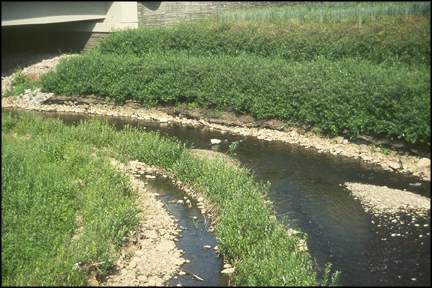
Photo 3
Soil bioengineering techniques provided bank protection and habitat benefits by the middle of the first growing season.
Salmon river restoration
The Kenai River is located on the Kenai Peninsula approximately 75 miles south of Anchorage, Alaska. The river drains more than 2,000 square miles of diverse landscape, including icefields, glaciers, lakes, mountains, and lowlands. The Kenai River is the state's premier salmon and trout stream and has a world-class reputation for its trophy chinook sport fishing.
Soldotna Creek Park attracts large numbers of fisherman and naturalists, and much of the bank vegetation had been destroyed. This, along with heavy foot traffic, boat wakes, and ice scour, has caused accelerated bank erosion and loss of riparian habitat. The Soldotna Park reach is 650 feet long and has low banks that are generally less than 3 feet high. This area is a very sensitive and fragile riparian wetland zone with high seepage conditions. (Photo 1).
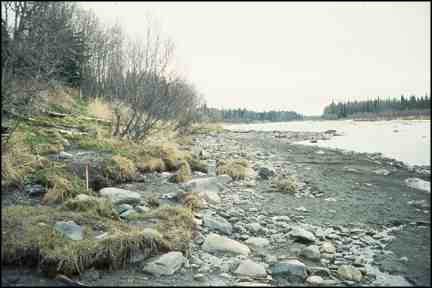
Photo 1
Fragile riparian zones and high seepage areas are common on parts of Alaska's Kenai River.
Due to the multi-objective requirements of the project, the city of Soldotna commissioned Robbin B. Sotir & Associates Inc. to perform the major assessment and design of the project, which would utilize specialized soil bioengineering techniques. The goals of the project were broad and were driven by seven different funding and permitting agencies.
The project goals were to stop the accelerated bank erosion, restore riparian habitat, improve fish habitat, and provide better access for recreational use.
Soil bioengineering methods were proposed to meet the project goals of habitat restoration, bank stabilization, and improved recreational use after consultants met with several state, federal, and local agencies. The proposed systems included low live cribwalls, live siltation construction, and native grass sods.
The living woody plant materials used included five native willows and one native rose species. The cuttings were harvested from sites located three to 25 miles away from the project and kept in refrigeration vans prior to installation. Plans, specifications and cost estimates were produced for the site. Soldotna Creek Park was constructed in the spring of 1994, during low water prior to spring runoff from the mountain snow melt. The live cribwalls were installed along the full length of the project. These included drainage systems to handle the seepage from the wetlands behind. The live siltation constructions were placed upstream in front of some sections of the live cribwall along with boulders to offer additional overhanging cover, scour pools, and turbulence for fish habitat (Photo 2).
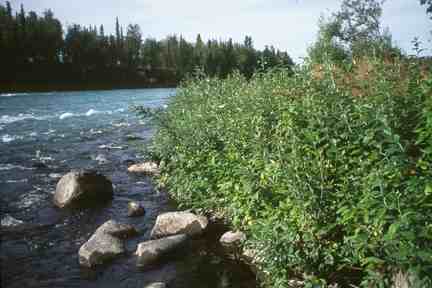
Photo 2
Live siltation constructions and cribwalls offer overhanging cover and scour pools.
Major flooding occurred during the fall of 1995 when discharge peaked at 42,000 cfs, a flow estimated to be in excess of a 100-year return interval event. Although the soil bioengineering installations were affected, damage was minimal. The willow used in the live cribwalls and live siltation constructions is providing excellent overhanging cover for fish despite browsing of new top growth by moose and deer.
The bank stabilization and restoration is encouraging the use and enjoyment of Soldotna Creek Park and the Kenai River to fishermen and nature lovers alike (Photo 3).
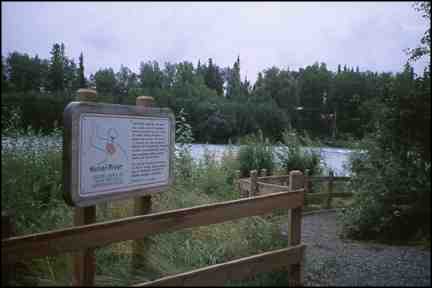
Photo 3
Education can be an important aspect of the success of soil bioengineering projects.
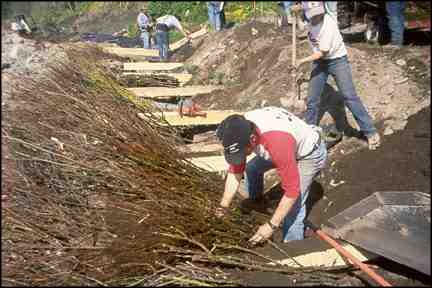
Photo 4
Live cribwalls are constructed of timbers, soil, rock, and live cuttings.
Summary
By their very nature, urban watershed restoration projects involve multiple objectives. In addition to controlling erosion in a cost-effective manner, communities are increasingly concerned with water quality, habitat, aesthetics, recreational use, and other environmental objectives. Soil bioengineering designs that are based on sound engineering practice and ecological principles employ live woody vegetation to meet these environmental objectives better than other types of streambank and upland slope protection that employ inert elements alone. Maximum benefits are derived by choosing a soil bioengineering system and selecting the correct vegetation to achieve the specific objectives. The success of soil bioengineering on Johnson Creek and the Kenai River (see sidebars) indicates that this approach to stabilization and restoration is successful.
![]()
Robbin Sotir is president of Robbin B. Sotir & Associates Inc., a soil bioengineering firm headquartered in Marietta, GA. Over the past 23 years, Ms. Sotir has completed more than 200 projects in North and Central America, Europe, and Southeast Asia. She has recently co-authored a book with Donald H. Gray, Ph.D., titled Biotechnical and Soil Bioengineering Slope Stabilization.
3221 Stoney Acres Drive
Kennesaw, Georgia 30152
Phone: 770-424-0719
sotir@sotir.com
©2020 Robbin B. Sotir & Asociates, Inc.